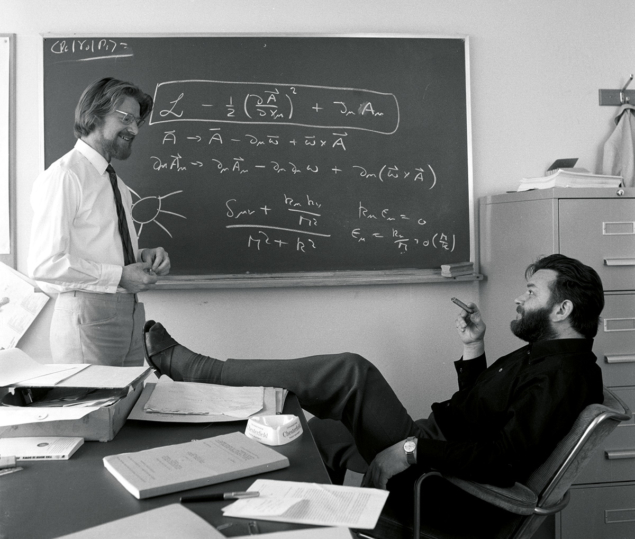
Eminent physicist and Nobel laureate Martinus Veltman passed away in his home town of Bilthoven, the Netherlands, on 4 January. Martinus (Tini) Veltman graduated in physics at Utrecht University, opting first for experimental physics but later switching to theory. After his conscript military service in 1959, Léon Van Hove offered him a position as a PhD student. Veltman started in Utrecht, but later followed Van Hove to the CERN theory division.
CERN opened up a new world, and Tini often mentioned how he benefited from contacts with John Bell, Gilberto Bernardini and Sam Berman. The latter got him interested in weak interactions and in particular neutrino physics. During his time there, Tini spent a short period at SLAC where he started to work on his computer algebra program “Schoonschip”. He correctly foresaw that practical calculations of Feynman diagrams would become more and more complicated, particularly for theories with vector bosons. Nowadays extended calculations beyond one loop are unthinkable without computer algebra.
In 1964 Murray Gell-Mann proposed an algebra of conserved current operators for hadronic matter, which included the weak and electromagnetic currents. He argued that commutators of two currents taken at the same instant in time should “close”, meaning that these commutators can be written as linear combinations of the same set of currents. From this relation one could derive so-called sum rules that can be compared to experiments. Facing the technical problems with this approach, Tini came up with an alternative proposal. In a 1966 paper he simply conjectured that the hadronic currents for the electromagnetic and weak interactions had to be covariantly conserved, where he assumed that the weak interactions were mediated by virtual vector bosons, just as electromagnetic processes are mediated by virtual photons. The current conservation laws therefore had to contain extra terms depending on the photon field and the fields associated with the weak intermediate vector bosons. Quite surprisingly, he could then demonstrate that these new conservation equations suffice to prove the same sum rules. A more important aspect of his approach was only gradually realised, namely that the conservation laws for these currents are characteristic of a non-abelian gauge theory as had been written down more than 10 years earlier by Yang and Mills. Hence Veltman started to work on the possible renormalisability of Yang–Mills theory.
From his early days at CERN it was clear that Tini had a strong interest in confronting theoretical predictions with experimental results
Meanwhile, Veltman had left CERN towards the end of 1966 to accept a professorship at Utrecht. At the end of 1969 a prospective PhD student insisted on working on Yang–Mills theories. Veltman, who was already well aware of many of the pitfalls, only gradually agreed, and so Gerard ’t Hooft joined the programme. This turned out to be a very fruitful endeavour and the work was proudly presented in the summer of 1971. Veltman and ’t Hooft continued to collaborate on Yang–Mills theory. Their 1972 papers are among the finest that have been written on the subject. In 1999 they shared the Nobel Prize in Physics “for elucidating the quantum structure of electroweak interactions”.
With the renormalisability of the electroweak theory established, precision comparisons with experiment were within reach, and Veltman started to work on these problems with postdocs and PhD students. One important tool was the so-called rho parameter (a ratio of the masses of the W and Z bosons and the weak mixing angle). Its experimental value was close to one, which showed that only models in which the Higgs field starts as a doublet are allowed. From the small deviations from one, it was possible to estimate the mass of the top quark, which was not yet discovered. Later, when CERN was planning to build the LEP collider, the emphasis changed to the calculation of one-loop corrections for various processes in e+e– collisions. As a member of the CERN Scientific Policy Committee (SPC), Veltman strongly argued that LEP should operate at the highest possible energy, well above the W+W– threshold, to study the electroweak theory with precision. The Standard Model has since passed all of these tests.
From his early days at CERN it was clear that Tini had a strong interest in confronting theoretical predictions with experimental results, and in the organisation needed to do so. To this end, he was one of a small group of colleagues in the Netherlands to push for a national institute for subatomic physics – Nikhef, which was founded in 1975. In 1981 Tini moved to the University of Michigan in Ann Arbor, returning to the Netherlands after his retirement in 1996.
Veltman made a lasting impact on the field of particle physics, and inspired many students. Until recently he followed what was happening in the field, regularly attending the September meetings of the SPC. Our community will miss his sharp reasoning and clear-eyed look at particle physics that are crucial for its development.








